陈述句变一般疑问句的变化规则
- 格式:doc
- 大小:44.00 KB
- 文档页数:2
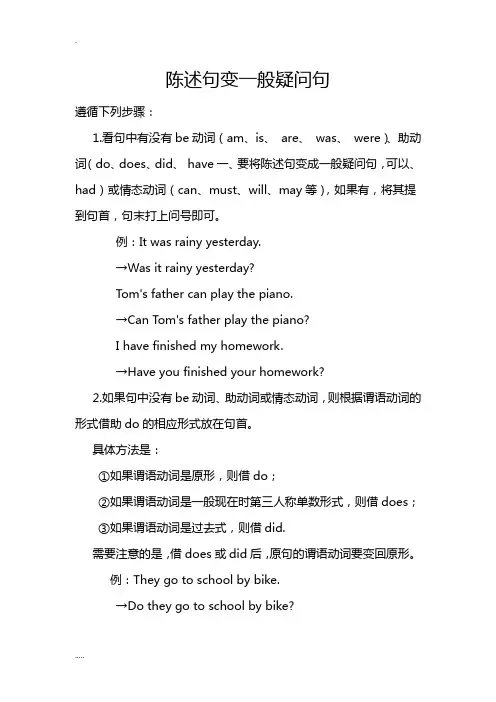
陈述句变一般疑问句遵循下列步骤:1.看句中有没有be动词(am、is、are、was、were)、助动词(do、does、did、have一、要将陈述句变成一般疑问句,可以、had)或情态动词(can、must、will、may等),如果有,将其提到句首,句末打上问号即可。
例:It was rainy yesterday.→Was it rainy yesterday?Tom's father can play the piano.→Can Tom's father play the piano?I have finished my homework.→Have you finished your homework?2.如果句中没有be动词、助动词或情态动词,则根据谓语动词的形式借助do的相应形式放在句首。
具体方法是:①如果谓语动词是原形,则借do;②如果谓语动词是一般现在时第三人称单数形式,则借does;③如果谓语动词是过去式,则借did.需要注意的是,借does或did后,原句的谓语动词要变回原形。
例:They go to school by bike.→Do they go to school by bike?Bill gets up at 6:30 every day.→Does bill gets up at 6:30 every day?The students saw a film yesterday.→Did the students see a film yesterday?二、陈述句变一般疑问句应注意的事项陈述句变成一般疑问句除了遵循上述规则以外,还应注意下列几点:1.如果陈述句中有第一人称,则变问句时最好要变为第二人称。
例:I usually have lunch at school.→Do you usually have lunch at school?My father is playing soccer.→Is your father playing soccer?2.如果陈述句中有some, 则变问句时往往要变成any 。
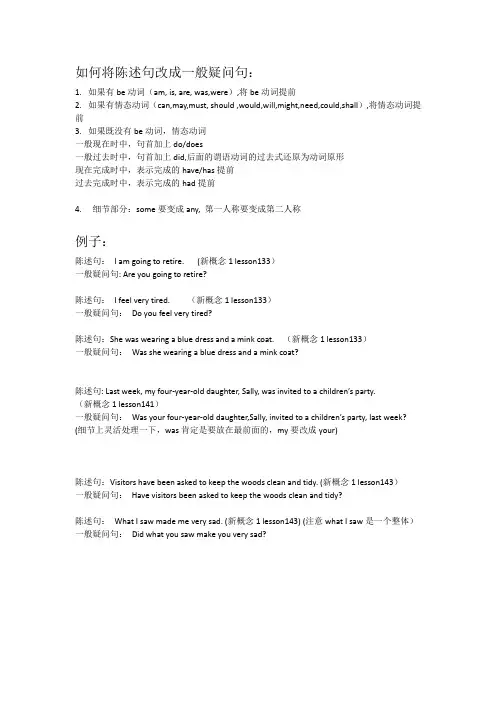
如何将陈述句改成一般疑问句:1.如果有be动词(am, is, are, was,were),将be动词提前2.如果有情态动词(can,may,must, should ,would,will,might,need,could,shall),将情态动词提前3.如果既没有be动词,情态动词一般现在时中,句首加上do/does一般过去时中,句首加上did,后面的谓语动词的过去式还原为动词原形现在完成时中,表示完成的have/has提前过去完成时中,表示完成的had提前4.细节部分:some要变成any, 第一人称要变成第二人称例子:陈述句:I am going to retire. (新概念1 lesson133)一般疑问句: Are you going to retire?陈述句:I feel very tired. (新概念1 lesson133)一般疑问句:Do you feel very tired?陈述句:She was wearing a blue dress and a mink coat. (新概念1 lesson133)一般疑问句:Was she wearing a blue dress and a mink coat?陈述句: Last week, my four-year-old daughter, Sally, was invited to a children’s party.(新概念1 lesson141)一般疑问句:Was your four-year-old daughter,Sally, invited to a children’s party, last week? (细节上灵活处理一下,was肯定是要放在最前面的,my要改成your)陈述句:Visitors have been asked to keep the woods clean and tidy. (新概念1 lesson143)一般疑问句:Have visitors been asked to keep the woods clean and tidy?陈述句:What I saw made me very sad. (新概念1 lesson143) (注意what I saw是一个整体)一般疑问句:Did what you saw make you very sad?练习:陈述句:The lady was dressed in a blue coat and a large,funny hat. (新1 lesson141)一般疑问句:陈述句:She put away her compact and smiled kindly. (新1 lesson141)一般疑问句:陈述句:The ground was covered with pieces of paper, cigarettes ends, old tires, empty bottles, and rusty tins. (新1 lesson143)一般疑问句:陈述句:Anyone who leaves litter in these woods will be prosecuted. (注意anyone who leaves litter in these woods是一个整体)(新1 lesson143)一般疑问句:。

小学英语陈述句变一般疑问句规则
一般疑问句是用来询问一个陈述句是否正确的句子。
在将陈述句变为
一般疑问句时,需要将陈述句的语序进行调整。
以下是小学英语中将陈述
句转换为一般疑问句的规则:
1. 当陈述句中有助动词(be动词)时,将助动词移到句首。
例如:
陈述句:He is a student.
一般疑问句:Is he a student?
2. 当陈述句中没有助动词时,需要在句首加上助动词do或does,
并且将原句中的动词用原形表示。
例如:
陈述句:They play soccer.
一般疑问句:Do they play soccer?
陈述句:She likes ice cream.
一般疑问句:Does she like ice cream?
注意:当主语是第三人称单数(he、she、it)时,要使用助动词does。
其他情况下使用助动词do。
3. 当陈述句中有疑问词(如who, what, where, when, why, how等)时,将疑问词移到句首,并且需要在句末加上问号。
例如:
陈述句:You go to school by bus.
一般疑问句:Do you go to school by bus?
陈述句:He lives in Shanghai.
一般疑问句:Where does he live?
需要注意的是,对于一般疑问句的回答,肯定回答用"Yes, "加上完整的句子,否定回答用"No, "加上完整的句子,并且需要将be动词、助动词、谓语动词等与主语进行一致变化。
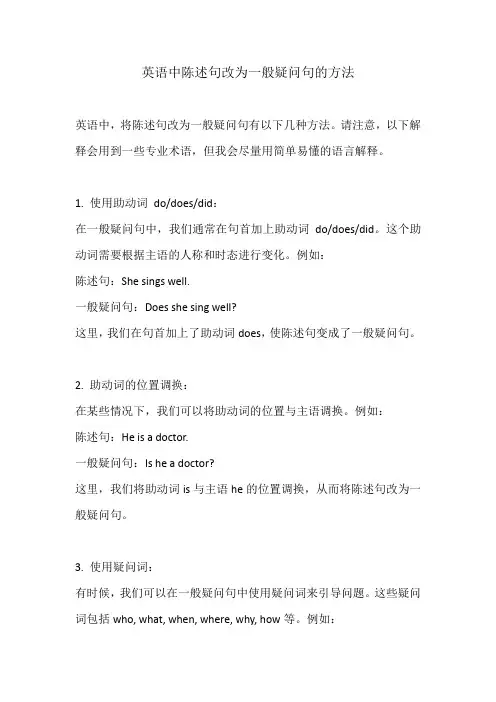
英语中陈述句改为一般疑问句的方法英语中,将陈述句改为一般疑问句有以下几种方法。
请注意,以下解释会用到一些专业术语,但我会尽量用简单易懂的语言解释。
1. 使用助动词do/does/did:在一般疑问句中,我们通常在句首加上助动词do/does/did。
这个助动词需要根据主语的人称和时态进行变化。
例如:陈述句:She sings well.一般疑问句:Does she sing well?这里,我们在句首加上了助动词does,使陈述句变成了一般疑问句。
2. 助动词的位置调换:在某些情况下,我们可以将助动词的位置与主语调换。
例如:陈述句:He is a doctor.一般疑问句:Is he a doctor?这里,我们将助动词is与主语he的位置调换,从而将陈述句改为一般疑问句。
3. 使用疑问词:有时候,我们可以在一般疑问句中使用疑问词来引导问题。
这些疑问词包括who, what, when, where, why, how等。
例如:陈述句:She went to the park.一般疑问句:Where did she go?这里,我们使用了疑问词where来引导问题,从而改变了陈述句的语序。
4. 使用倒装语序:在某些特殊情况下,我们可以使用倒装语序来构成一般疑问句。
具体来说,就是将助动词放在主语之前。
例如:陈述句:You have finished the work.一般疑问句:Have you finished the work?这里,我们将助动词have放在主语you之前,实现了倒装语序。
需要注意的是,这些方法可以单独使用,也可以结合使用,具体取决于句子的结构和语境。
同时,不同的时态和人称也会对这些方法产生影响。
总之,将陈述句改为一般疑问句可以通过加助动词、调换助动词位置、使用疑问词或倒装语序来实现。
这些方法在英语中非常常见,帮助我们构造问句并进行有效的交流。
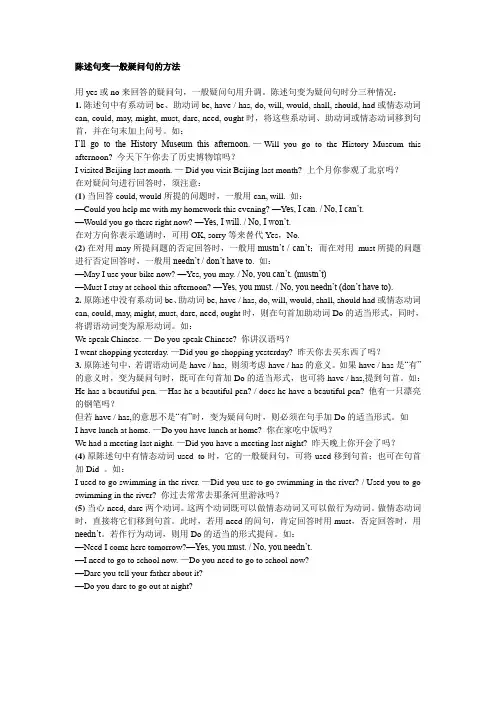
陈述句变一般疑问句的方法用yes或no来回答的疑问句,一般疑问句用升调。
陈述句变为疑问句时分三种情况:1.陈述句中有系动词be、助动词be, have / has, do, will, would, shall, should, had或情态动词can, could, may, might, must, dare, need, ought时,将这些系动词、助动词或情态动词移到句首,并在句末加上问号。
如:I’ll go to the History Museum this afternoon.— Will you go to the History Museum this afternoon? 今天下午你去了历史博物馆吗?I visited Beijing last month. — Did you visit Beijing last month? 上个月你参观了北京吗?在对疑问句进行回答时,须注意:(1)当回答could, would所提的问题时,一般用can, will. 如:—Could you help me with my homework this evening? —Y es, I can. / No, I can’t.—Would you go there right now? —Yes, I will. / No, I won’t.在对方向你表示邀请时,可用OK, sorry等来替代Yes,No.(2)在对用may所提问题的否定回答时,一般用mustn’t / can’t;而在对用must所提的问题进行否定回答时,一般用needn’t / don’t have to. 如:—May I use your bike now? —Yes, you may. / No, you can’t. (mustn’t)—Must I stay at school this afternoon? —Yes, you must. / No, you needn’t (don’t have to).2.原陈述中没有系动词be、助动词be, have / has, do, will, would, shall, should had或情态动词can, could, may, might, must, dare, need, ought时,则在句首加助动词Do的适当形式,同时,将谓语动词变为原形动词。
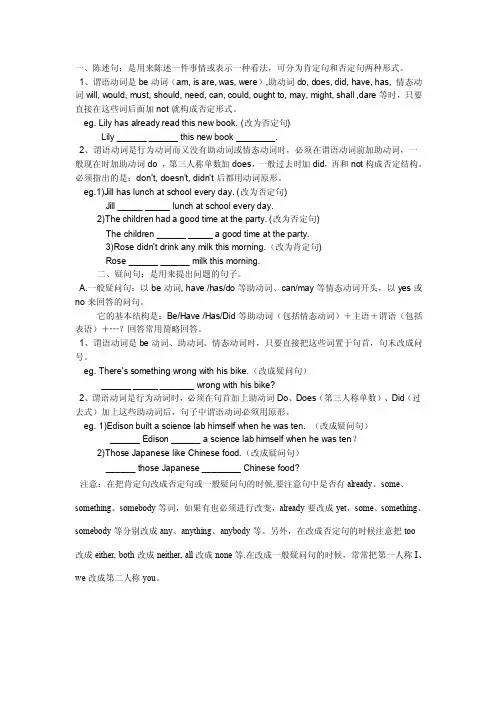
一、陈述句:是用来陈述一件事情或表示一种看法,可分为肯定句和否定句两种形式。
1、谓语动词是be动词(am, is are, was, were),助动词do, does, did, have, has, 情态动词will, would, must, should, need, can, could, ought to, may, might, shall ,dare等时,只要直接在这些词后面加not就构成否定形式。
eg. Lily has already read this new book. (改为否定句)Lily ______ ______ this new book ________.2、谓语动词是行为动词而又没有助动词或情态动词时,必须在谓语动词前加助动词,一般现在时加助动词do ,第三人称单数加does,一般过去时加did,再和not构成否定结构。
必须指出的是:don't, doesn't, didn't后都用动词原形。
eg.1)Jill has lunch at school every day. (改为否定句)Jill _____ _____ lunch at school every day.2)The children had a good time at the party. (改为否定句)The children ______ _____ a good time at the party.3)Rose didn't drink any milk this morning.(改为肯定句)Rose ______ ______ milk this morning.二、疑问句:是用来提出问题的句子。
A.一般疑问句:以be动词, have /has/do等助动词、can/may等情态动词开头,以yes或no来回答的问句。
它的基本结构是:Be/Have /Has/Did等助动词(包括情态动词)+主语+谓语(包括表语)+┄?回答常用简略回答。
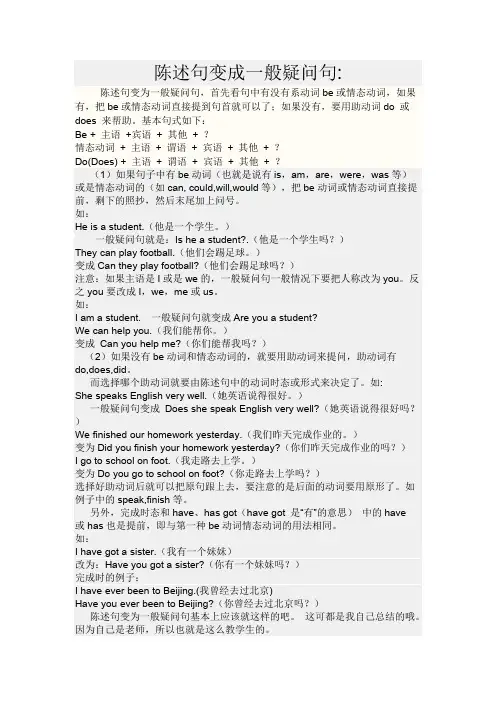
陈述句变成一般疑问句:陈述句变为一般疑问句,首先看句中有没有系动词be或情态动词,如果有,把be或情态动词直接提到句首就可以了;如果没有,要用助动词do 或does 来帮助。
基本句式如下:Be + 主语+宾语+ 其他+ ?情态动词+ 主语+ 谓语+ 宾语+ 其他+ ?Do(Does) + 主语+ 谓语+ 宾语+ 其他+ ?(1)如果句子中有be动词(也就是说有is,am,are,were,was等)或是情态动词的(如can, could,will,would等),把be动词或情态动词直接提前,剩下的照抄,然后末尾加上问号。
如:He is a student.(他是一个学生。
)一般疑问句就是:Is he a student?.(他是一个学生吗?)They can play football.(他们会踢足球。
)变成Can they play football?(他们会踢足球吗?)注意:如果主语是I或是we的,一般疑问句一般情况下要把人称改为you。
反之you要改成I,we,me或us。
如:I am a student. 一般疑问句就变成Are you a student?We can help you.(我们能帮你。
)变成Can you help me?(你们能帮我吗?)(2)如果没有be动词和情态动词的,就要用助动词来提问,助动词有do,does,did。
而选择哪个助动词就要由陈述句中的动词时态或形式来决定了。
如:She speaks English very well.(她英语说得很好。
)一般疑问句变成Does she speak English very well?(她英语说得很好吗?)We finished our homework yesterday.(我们昨天完成作业的。
)变为Did you finish your homework yesterday?(你们昨天完成作业的吗?)I go to school on foot.(我走路去上学。
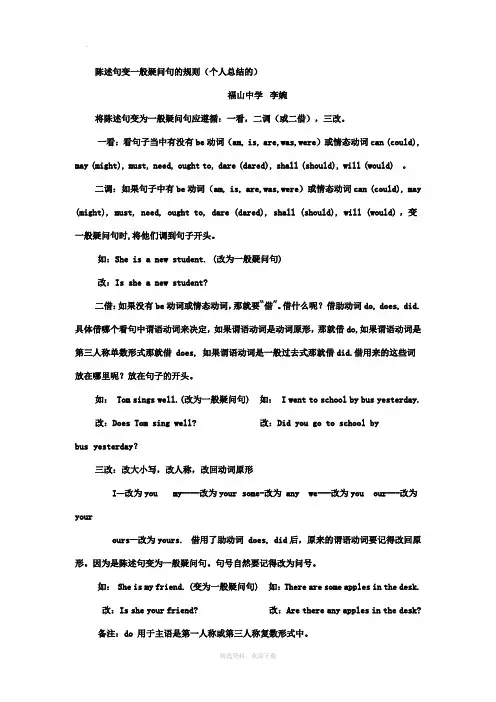
陈述句变一般疑问句的规则(个人总结的)福山中学李婉将陈述句变为一般疑问句应遵循:一看,二调(或二借),三改。
一看:看句子当中有没有be动词(am, is, are,was,were)或情态动词can (could), may (might), must, need, ought to, dare (dared), shall (should), will (would)。
二调:如果句子中有be动词(am, is, are,was,were)或情态动词can (could), may (might), must, need, ought to, dare (dared), shall (should), will (would),变一般疑问句时,将他们调到句子开头。
如:She is a new student. (改为一般疑问句)改:Is she a new student?二借:如果没有be动词或情态动词,那就要“借”。
借什么呢?借助动词do, does, did.具体借哪个看句中谓语动词来决定,如果谓语动词是动词原形,那就借do,如果谓语动词是第三人称单数形式那就借 does, 如果谓语动词是一般过去式那就借did.借用来的这些词放在哪里呢?放在句子的开头。
如: Tom sings well.(改为一般疑问句)如: I went to school by bus yesterday.改:Does Tom sing well?改:Did you go to school bybus yesterday?三改:改大小写,改人称,改回动词原形I—改为you my----改为your some-改为 any we---改为you our---改为yourours—改为yours.借用了助动词 does, did后,原来的谓语动词要记得改回原形。
因为是陈述句变为一般疑问句。
句号自然要记得改为问号。
如: She is my friend. (变为一般疑问句)如:There are some apples in the desk.改:Is she your friend?改:Are there any apples in the desk?备注:do 用于主语是第一人称或第三人称复数形式中。
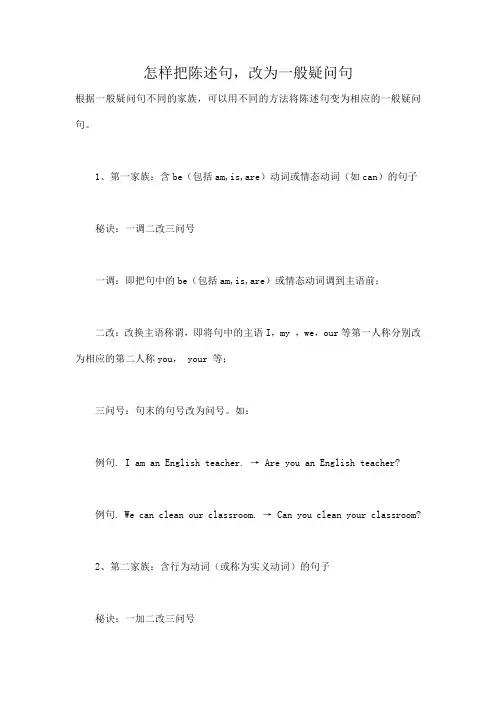
怎样把陈述句,改为一般疑问句
根据一般疑问句不同的家族,可以用不同的方法将陈述句变为相应的一般疑问句。
1、第一家族:含be(包括am,is,are)动词或情态动词(如can)的句子
秘诀:一调二改三问号
一调:即把句中的be(包括am,is,are)或情态动词调到主语前;
二改:改换主语称谓,即将句中的主语I,my ,we,our等第一人称分别改为相应的第二人称you, your 等;
三问号:句末的句号改为问号。
如:
例句. I am an English teach er. → Are you an English teacher?
例句. We can clean our classroom. → Can you clean your classroom?
2、第二家族:含行为动词(或称为实义动词)的句子
秘诀:一加二改三问号
一加:即在句首加助动词Do或Does;
二改:1、把谓语动词改为原形;2、改换主语称谓(同第一家组);
三问号:句末的句号改为问号。
例句. We read English every morning. → Do you read English every morning?
例句. My father likes English very much. →
Does your father like English very much ?
特别注意:对于第二家族一定要注意动词的还原,因为时态与数的变化已经体现在助动词上了。
3、加强记忆口诀:
“肯变一,并不难,can 或be(包括am,is,are)提在前;
谓语若为行为动,do 或does句首用。
”。
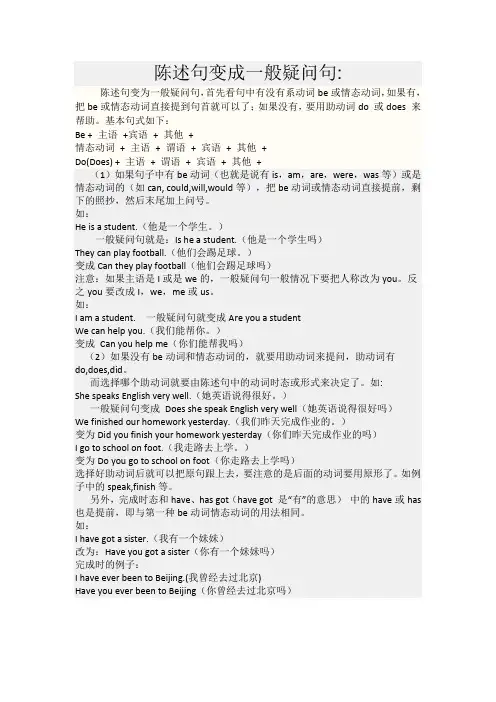
陈述句变成一般疑问句:陈述句变为一般疑问句,首先看句中有没有系动词be或情态动词,如果有,把be或情态动词直接提到句首就可以了;如果没有,要用助动词do 或does 来帮助。
基本句式如下:Be + 主语+宾语+ 其他+情态动词+ 主语+ 谓语+ 宾语+ 其他+Do(Does) + 主语+ 谓语+ 宾语+ 其他+(1)如果句子中有be动词(也就是说有is,am,are,were,was等)或是情态动词的(如can, could,will,would等),把be动词或情态动词直接提前,剩下的照抄,然后末尾加上问号。
如:He is a student.(他是一个学生。
)一般疑问句就是:Is he a student.(他是一个学生吗)They can play football.(他们会踢足球。
)变成Can they play football(他们会踢足球吗)注意:如果主语是I或是we的,一般疑问句一般情况下要把人称改为you。
反之you要改成I,we,me或us。
如:I am a student. 一般疑问句就变成Are you a studentWe can help you.(我们能帮你。
)变成Can you help me(你们能帮我吗)(2)如果没有be动词和情态动词的,就要用助动词来提问,助动词有do,does,did。
而选择哪个助动词就要由陈述句中的动词时态或形式来决定了。
如:She speaks English very well.(她英语说得很好。
)一般疑问句变成Does she speak English very well(她英语说得很好吗)We finished our homework yesterday.(我们昨天完成作业的。
)变为Did you finish your homework yesterday(你们昨天完成作业的吗)I go to school on foot.(我走路去上学。
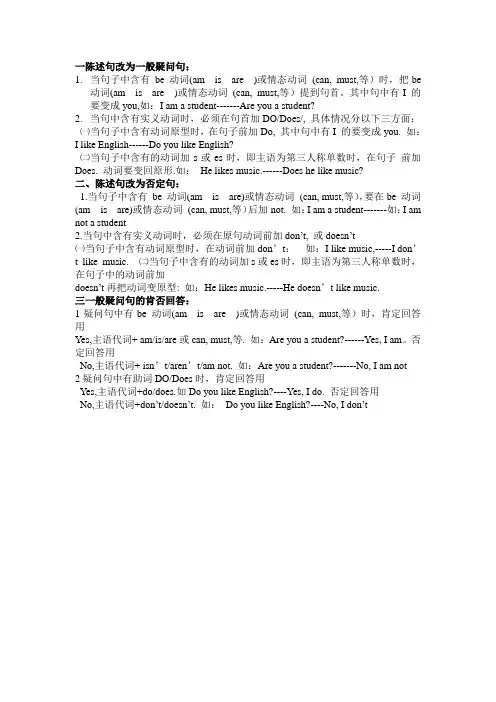
一陈述句改为一般疑问句:1.当句子中含有be 动词(am is are )或情态动词(can, must,等)时,把be动词(am is are )或情态动词(can, must,等)提到句首。
其中句中有I 的要变成you,如:I am a student-------Are you a student?2.当句中含有实义动词时,必须在句首加DO/Does/, 具体情况分以下三方面:㈠当句子中含有动词原型时,在句子前加Do, 其中句中有I 的要变成you. 如:I like English------Do you like English?㈡当句子中含有的动词加s或es时,即主语为第三人称单数时,在句子前加Does. 动词要变回原形.如:He likes music.------Does he like music?二、陈述句改为否定句:1.当句子中含有be 动词(am is are)或情态动词(can, must,等),要在be 动词(am is are)或情态动词(can, must,等)后加not. 如:I am a student-------如:I am not a student2.当句中含有实义动词时,必须在原句动词前加don’t, 或doesn’t㈠当句子中含有动词原型时,在动词前加don’t:如:I like music,-----I don’t like music. ㈡当句子中含有的动词加s或es时,即主语为第三人称单数时,在句子中的动词前加doesn’t再把动词变原型: 如:He likes music.-----He doesn’t like music.三一般疑问句的肯否回答:1疑问句中有be 动词(am is are )或情态动词(can, must,等)时,肯定回答用Yes,主语代词+ am/is/are或can, must,等. 如:Are you a student?------Yes, I am。
一般现在时态中只有实义动词的陈述句变成一般疑问句的变形规则:1.找出实义动词;2.判断主语是否是三单还是非三单;3.有借有还原则:借助动词实义动词需还原。
三单借does/doesn’t; 非三单借do/don’t。
4.实义动词还原,其他不变照抄,句号变问号。
5.一二人称互换:I/we需变成you. my变成your。
助动词包括:do does don’t doesn’t1.My mother reads a book every day.陈述句Does your mother read a book every day?一般疑问句Yes, she does.She reads a book every day.肯定短句。
肯定句。
No, she doesn’t. She doesn’t read a book every day.否定短句。
否定句。
2.I usually play football on Sundays.Do you usually play football on Sundays?Yes, I do. I usually play football on Sundays.No, I don’t. I don’t usually play football on Sundays.1.肯定句中无助动词。
2.助动词后加动词原形。
3.助动词无实际意义,起辅助作用。
4.三单的好朋友是does/doesn’t; 非三单的好朋友是do/don’t。
特殊疑问句词总结:1.what“什么”,对物品提问;对动作提问2.what color“什么颜色”,对颜色提问3.where“哪里”,对地点提问4.what time“什么时间”,对小时间提问5.when“什么时候”。
对大时间提问6.what day“星期几”,对星期提问7.how old“几岁”,对年龄提问8.how“怎样”,对方式提问特殊疑问句特殊疑问句=特殊疑问词+一般疑问句对动词短语提问用what,动词短语用do代替。
英语中陈述句变一般疑问句的口诀在英语学习中,陈述句变一般疑问句是一个重要的语法点。
掌握这个转换规则对于正确理解和运用英语至关重要。
为了帮助大家更轻松地掌握这一知识点,下面给大家分享一个实用的口诀。
“有 be 用 be,有情用情,无 be 无情借 do/does,三单 does 加原形,其他人称用 do。
”接下来咱们详细拆解一下这个口诀。
“有 be 用be”,意思是如果陈述句中本来就有 be 动词(am/is/are/was/were),那么在变一般疑问句时,直接把 be 动词提到句首。
比如,“She is a teacher” 变成一般疑问句就是“Is she a teacher?” 再比如,“They were happy yesterday” 变成一般疑问句就是“Were they happy yesterday?”“有情用情”指的是如果陈述句中有情态动词(can/could/may/might/must/should/ought to/will/would/need等),变一般疑问句时,将情态动词提到句首。
例如,“He can swim” 变为一般疑问句就是“Can he swim?” 又如,“We should study hard” 变成一般疑问句就是“Should we study hard?”“无 be 无情借do/does”,这是说当陈述句中既没有 be 动词,也没有情态动词的时候,就要借助助动词 do/does 来帮忙。
具体用 do 还是does,取决于主语。
“三单 does 加原形”,如果主语是第三人称单数(he/she/it 或者单个的人名、事物名称等),我们就用does,并且后面的动词要变回原形。
比如,“He likes apples” 变成一般疑问句就是“Does he like apples?” 这里注意,likes 要变回 like。
“其他人称用do”,除了第三人称单数之外的其他人称(I/we/you/they 等),我们用 do 来构成一般疑问句,后面的动词用原形。
可编写可改正一、一般疑问句或No作答的疑问句叫一般疑问句。
2、特色:1、以be动词、神态动词(can,could,should ),助动词(do,does)开头;例:IsyourfatherateacherDoesTomlikeapplesCanJennyspeakEnglish2 、常常读升调.3、陈说句变为一般疑问句的方法:1>看陈说句中有没有be动词(am、is、are、)或神态动词(can,could,should),只要要将其提到句首,句末打上问号即可。
例:Itisrainy.IsitrainyTom'sfathercanplaythepiano.→CanTom'sfatherplaythepiano2>假如句中没有be动词或神态动词,句首加 do、does、的相应形式。
实义动词是原型时,用Do发问,实义动词不变。
实义动词是单三形式时,用Does发问,再把实义动词变为原形,句末加问号。
gotoschoolbybike. →Dotheygotoschoolbybikegetsupat6:30everyday. →Doesbill getsupat6:30everyday注:1.假如陈说句中有第一人称(I,We)要变为第二人称(you)Iusuallyhavelunchatschool. →Doyouusuallyhavelunchatschool假如陈说句中有some,则变问句时常常要变为any。
Thereissomewaterontheplayground. →Isthereanywatero ntheplayground4、一般疑问句的回答。
(用什么发问就用什么回答)例:DoesshecleanherroomeverydayYes,shedoes.IsAnna′sfatheradoctorNo,heisn′t.Canshedance Yes,shecan..假如问句主语是thisthat, 回答时用it 取代;若问句主语是these,those,111可编写可改正回答时用they 取代。
肯定句陈述句变否定句陈述句口诀:
找到be、助、情,直接加not,some变any;
无be、无助、也无情,要请3d(do/does/did)来帮忙(放人称代词后,并加not),
3d是个照妖镜,动词见了现原形。
陈述句变一般疑问句口诀:(一调二改三问号,一加二改三问号)
找到be、助、情,直接提句首,人称一变二,some变any,句号变问号;
无be、无助、也无情,要请3d(do/does/did)来帮忙(放句首),
3d是个照妖镜,动词见了现原形。
陈述句对划线部分提问口诀:(一替,二改,三提,四问号)
提问题并不难,去提部分加特词,一般转完再提特;
问主语(who/what)不变序,其余部分抄原句。
注:疑问词是w或h作词首,所以特殊疑问句可称为wh疑问句,主要是对句子的某一成分进行提问。
特殊疑问词口诀:
什么什么用what,年龄要用how old,who who你是谁,where where在哪里,
whose谁的,how如何,which是问哪一个,when when问时间,what time几点了,
how long问多长,how many/how much问多少,how often问频率,
what color问颜色,what class问班级,what grade问年级。
陈述句变一般疑问句(人称是第一人称时,要变成第二人称)1. 陈述句中有be动词时,把be动词提到主语前面,将句号变成问号。
I am a student. → Are you a student ?She is a girl. →Is she a girl ?2. 陈述句中有情态动词时,把情态动词提到主语前面,将句号变成问号。
I can swim. → Can you swim ?They will go to school next month. →Will they go to school next month?3. 陈述句中有实意动词时,我们要借助助动词来帮助提问,动词要变成原形①当句中动词是原形时,我要借助do来提问They like playing the piano.→Do they like playing the piano?We have a great time at school. → Do we have a great time at school?②当句子中动词是第三人称单数时,我们要借助助动词does来提问,动词要变成原形She waters the plants every day.→ Does she water the plants every day?He goes to school five times a week.→ Does he go to school five times a week?She does her housework every day.→ Does she do her housework every day?③当句子中动词时过去式时,我们要借助助动词did来提问,动词要变成原形We watched TV last night.→ Did we watch TV last night?They enjoyed theirselves at the party.→ Did they enjoy theirselves at the party?当句子中有some,要把some变成any。